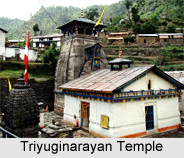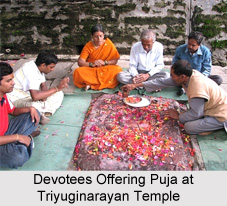 Triyuginarayan Temple is a Hindu temple nestled in the Uttarakhand state of India. The temple is built in the honour of Lord Vishnu. It is said that the marriage of Lord Shiva and Parvati took place here at the Brahma Shila in Satyug. Lord Brahma was the priest who conducted the marriage and Lord Narayana offered his sister Parvati to Lord Shiva. It is said that the marriage Havan Kund has been kept burning for three Yugas. That is why the temple is also called Akhand Dhuni temple. Pilgrims offer pieces of Havan in the Kund and take home the ashes as Prasada.
Triyuginarayan Temple is a Hindu temple nestled in the Uttarakhand state of India. The temple is built in the honour of Lord Vishnu. It is said that the marriage of Lord Shiva and Parvati took place here at the Brahma Shila in Satyug. Lord Brahma was the priest who conducted the marriage and Lord Narayana offered his sister Parvati to Lord Shiva. It is said that the marriage Havan Kund has been kept burning for three Yugas. That is why the temple is also called Akhand Dhuni temple. Pilgrims offer pieces of Havan in the Kund and take home the ashes as Prasada.
Etymology of Triyuginarayan Temple
Triyuginarayan is composed of three words including tri, yugi and Narayan.
Here tri means three and yugi denotes the period of time - Yuga. Narayan is another name of Lord Vishnu. It is called Triyuginaraya because the devotees have been offering wood to the fire in the havana-kund since the three Yugas.
Location of Triyuginarayan Temple
It is located in the Triyuginarayan village in Rudraprayag district of Uttarakhand. It is situated about 5 kms away from Sonprayag, the meeting point of rivers Mandakini and Songanga.
 Architecture of Triyuginarayan Temple
Architecture of Triyuginarayan Temple
Triyuginarayan Temple is famous for its architectural style which resembles the temple of Kedarnath. Said to have been built by Adi Shankaracharya, the temple houses two foot silver deity of Lord Vishnu, with Goddess Lakshmi and Goddess Saraswati on either side. The havana-kund with the eternal flame is situated in front of the temple. Devotees add samidha to the flame and collect the ashes as blessings. There is a stone called the Brahma Shila placed in front of the temple. This stone marks the spot where the divine marriage of Lord Shiva and Parvati was performed. There are four Holy Kunds here including Vishnu Kund, Rudra Kund, Brahma Kund and Saraswati Kund.
Connectivity to Triyuginarayan Temple
The temple is well linked via airway and railway. The nearest airport is Dehradun which is around 244 kilometres from Triyuginarayan. The nearest railhead is at Rishikesh which is around 261 kilometres from the temple. It is also accessed by trekking and the most famous route followed is from Mussoorie.






